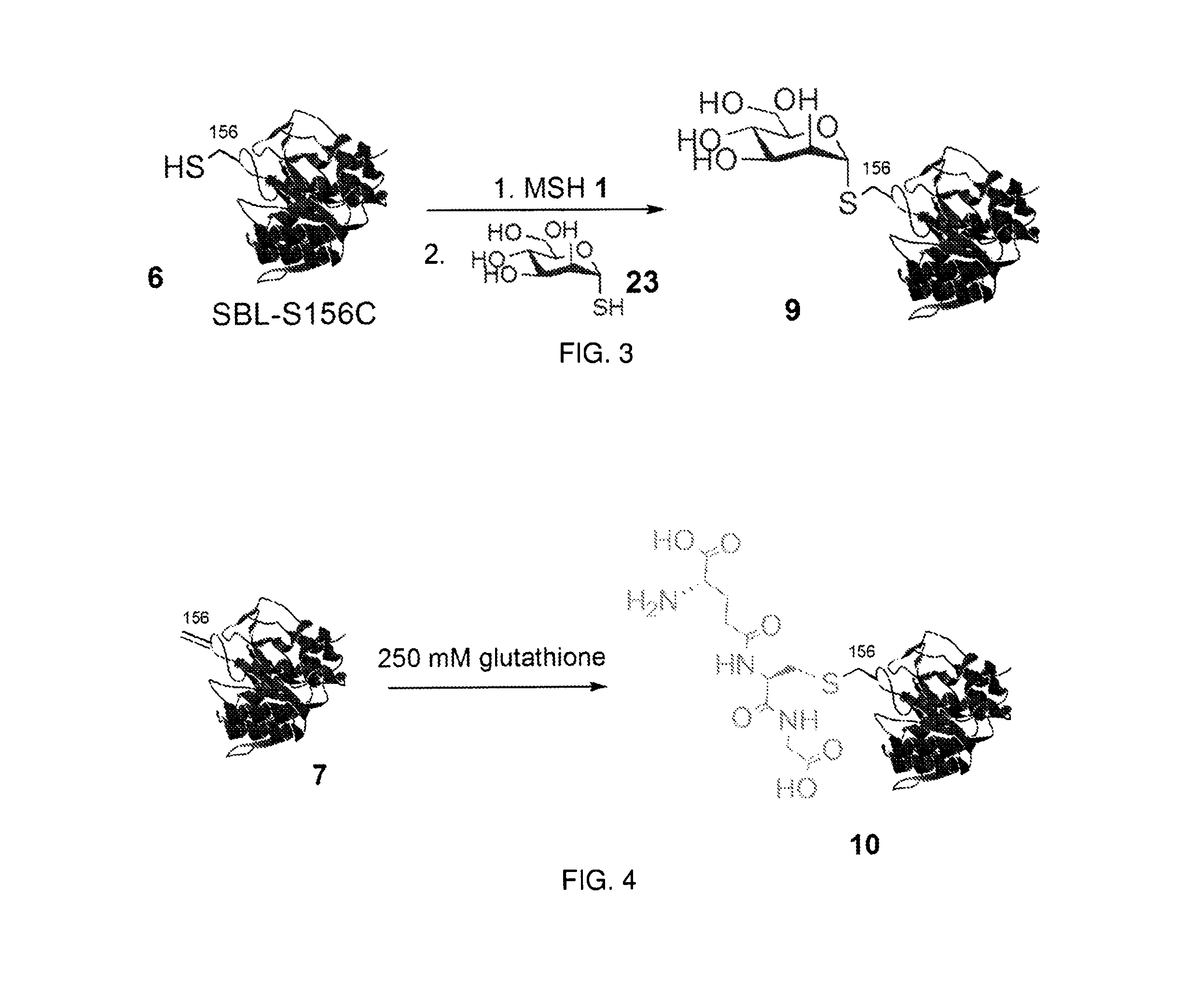Chemical modification of proteins
a technology of chemical modification and protein, which is applied in the direction of peptides, peptide/protein ingredients, peptide sources, etc., can solve the problem of unfeasible synthesis of polypeptides greater than 70 residues in length
- Summary
- Abstract
- Description
- Claims
- Application Information
AI Technical Summary
Benefits of technology
Problems solved by technology
Method used
Image
Examples
example 1
methyl 2-[(tert-butoxycarbonyl)amino]acrylate
[0057]
[0058]MSH 1 (439 mg, 2.0 mmol) was added to a 10 mL round bottom flask and dissolved in DMF (3 mL). In a separate vial, N-(tert-butoxycarbonyl)-L-cysteine methyl ester 2 (48 mg, 0.20 mmol) was added and dissolved in DMF (3 mL). The vial was cooled to 0° C. and a solution of potassium carbonate (138 mg, 1.0 mmol) in water (3.0 mL) was added. The resulting solution was added dropwise by pipette over a period of 3 min to the stirred MSH solution at room temperature. The vial was rinsed with DMF (2×1 mL) to ensure complete transfer. TLC (petrol:ethyl acetate, 4:1) analysis after completion of the addition revealed a single, UV active product (Rf 0.6). The reaction mixture was transferred to a separatory funnel and diluted with diethyl ether (150 mL) and water (100 mL). After separation, the organic layer was washed successively with water (80 mL) and brine (80 mL) before drying (MgSO4) and filtering. The solvent was removed under reduce...
example 2
Methionine Recovery from Corresponding Sulfilimine
[0060]
[0061]N-(tert-Butoxycarbonyl)-L-methionine methyl ester 4 (245 mg, 0.93 mmol) was added to a 50 mL round bottom flask and then dissolved in DMF (5 mL). The solution was stirred vigorously while water (5 mL) was added by pipette. MSH 1 (400 mg, 1.86 mmol) was added to the solution in one portion and the cloudy suspension homogenized after 30 seconds of stirring. After 5 minutes, TLC analysis revealed complete consumption of 4. All material was located on the baseline, and no sulfoxide 18 or sulfone 19 was detected. After 20 minutes of stirring, DTT (1.43 g, 1.86 mmol) was added as a solid. TLC analysis revealed no change after 1 hour of stirring. After 1 hour of total reaction time, Na2HPO4.12H2O (3.33 g, 9.30 mmol) was added to give a saturated solution of phosphate salts. After 2 hours of total reaction time (1 hour with base), TLC (30% ethyl acetate in petrol) revealed the regeneration of 4. A final hour of reaction time reve...
example 3
Regeneration of BocDhaOMe 3 from BocCys(SEt)OMe 15
[0063]
[0064]N-(tert-Butoxycarbonyl)-ethylthio-L-cysteine methyl ester 15 (106 mg, 0.40 mmol) was added to a 50 mL round bottom flask and dissolved in DMF (5 mL). Potassium carbonate (278 mg, 2.01 mmol) was added by pipette as a solution in water (1.0 mL). MSH 1 (172 mg 0.80 mmol) was added as a solid in one portion (open air, room temperature). TLC analysis (ethyl acetate:petrol; 1:4) after 1 min of reaction revealed a strongly UV active product (Rf 0.6) and a trace of starting material (Rf 0.5). A second dose of MSH 1 (172 mg 0.80 mmol) was added after 5 min of reaction time and TLC analysis revealed only the UV active product. After 10 min of total reaction time, the reaction mixture was diluted with diethyl ether (100 mL) and water (50 mL). The organic layer was separated and the aqueous layer was extracted with diethyl ether (2×50 mL). The combined organics were dried (MgSO4), filtered, and the solvent removed by rotary evaporati...
PUM
| Property | Measurement | Unit |
|---|---|---|
| pH | aaaaa | aaaaa |
| temperature | aaaaa | aaaaa |
| path length | aaaaa | aaaaa |
Abstract
Description
Claims
Application Information
 Login to View More
Login to View More - R&D
- Intellectual Property
- Life Sciences
- Materials
- Tech Scout
- Unparalleled Data Quality
- Higher Quality Content
- 60% Fewer Hallucinations
Browse by: Latest US Patents, China's latest patents, Technical Efficacy Thesaurus, Application Domain, Technology Topic, Popular Technical Reports.
© 2025 PatSnap. All rights reserved.Legal|Privacy policy|Modern Slavery Act Transparency Statement|Sitemap|About US| Contact US: help@patsnap.com



